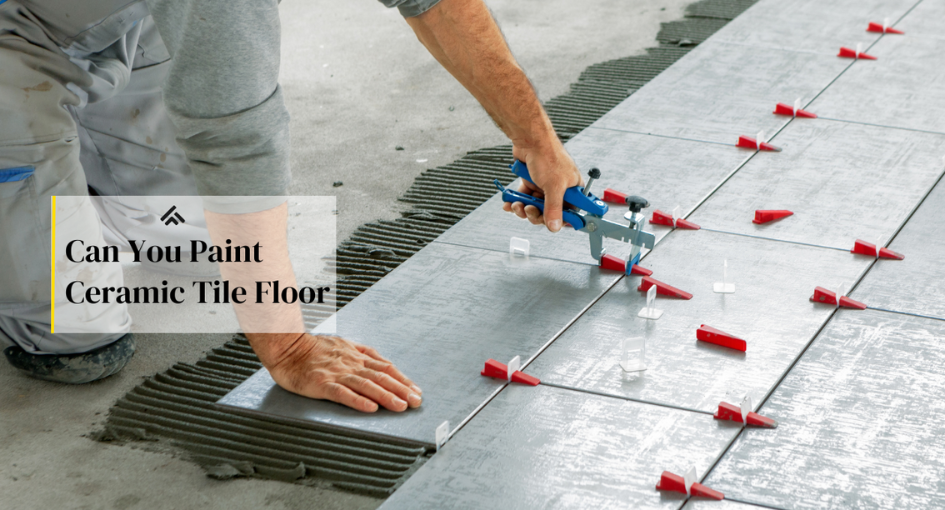Have you ever looked at your outdated ceramic tile floors and wished you could change their color without the hassle of replacing them? Well, you’re not alone. Many homeowners dream of a quick and easy way to update their flooring without breaking the bank.
Luckily, there’s a growing trend that might just be the solution; painting ceramic tile floors. Yes, you read that right! With a few simple steps and some creativity, it is possible to completely transform your ceramic tile floors into stunning new ones with just a coat of paint.
I’ll explore this DIY technique in detail and answer all your burning questions. Get ready to discover the exciting world of painted ceramic tile floors!
Step-by-Step Guide on How to Paint Ceramic Tile Floor
Painting ceramic tile floors is a cost-effective way to change the look of a room without the expense and hassle of re-tiling. The key to a successful paint job is preparation and using the right materials. Here’s a step-by-step guide on how to do it with the help of Commercial Flooring Estimator:
Materials and Tools Needed:
-
Fine grit sandpaper (220 grit or higher)
-
Vacuum cleaner (with a brush attachment)
-
Mop and bucket
-
Degreasing cleaner or TSP (Trisodium Phosphate)
-
Painter’s tape
-
Primer (epoxy-based for best results)
-
Porcelain or ceramic tile paint (floor grade)
-
Foam roller and paintbrushes
-
Clear urethane coat (water-based for low odor)
-
Safety gear (gloves, mask, goggles)
Clean the Floor
Thoroughly clean the tile floor with a degreasing cleaner or trisodium phosphate (TSP) to effectively eliminate all accumulated dirt, stubborn grease marks, and pesky grime. This meticulous cleaning step plays a pivotal role in ensuring optimal paint adhesion for a flawless finish.
Sand the Surface
Lightly sand the tile surface with fine-grit sandpaper to roughen it slightly, aiding in better adherence of the primer. Ensure gentle sanding to avoid damaging the tiles. Once sanded, thoroughly vacuum and mop the floor to meticulously remove any lingering dust particles.
Apply Painter’s Tape
When embarking on a painting project, it’s advisable to utilize painter’s tape to safeguard the lower sections of walls, cabinets, or any fixtures that should remain free of paint. This simple yet effective step helps maintain clean lines and prevents accidental smudges or spills, ensuring a professional-looking finish.
Prime the Tiles
To ensure optimal adhesion and protection, apply a thin, even coat of epoxy-based primer using a high-quality foam roller, which helps to achieve a smooth finish. For edges and intricate spots, utilize a brush for precise application. Allow the primer to dry thoroughly following the manufacturer’s guidelines, typically requiring around 24 hours for complete curing.
Paint the Tiles
Apply the first coat of paint specifically designed for ceramic or porcelain tiles. Ensure to use a high-quality foam roller to achieve a smooth and even finish. Allow the initial coat to dry thoroughly for a minimum of 24 hours before proceeding with the application of the second coat. Depending on the chosen paint color and type, you might find it necessary to apply additional coats to achieve full coverage and the desired aesthetic result.
Apply a Clear Urethane Coat
After the final paint coat has thoroughly dried (please refer to the manufacturer’s specified drying time for accuracy), it is advisable to proceed by applying a clear urethane coat. This additional step serves the purpose of safeguarding the painted surface, enhancing its durability and resilience against moisture and wear over time. For optimal results in achieving a sleek finish, it is recommended to utilize a fresh foam roller during the application process.
Let It Cure
To allow the floor to properly cure, it is advisable to wait for several days before walking on it. Additionally, it is recommended to avoid placing furniture or rugs on the surface for a minimum of two weeks. This waiting period will help ensure that the paint fully hardens, leading to a more durable and long-lasting finish.
By following these steps, you can transform your ceramic tile floor with a fresh, new look. Remember, while painting tile floors is a relatively straightforward
To read more articles visit GuestPostWorld
Conclusion
The idea of painting ceramic tile floors may have seemed daunting at first, but hopefully this blog post has shown you that it is a fun and creative project that can completely transform the look of any room. By following the steps outlined in this post, you can achieve a professional-looking painted floor without breaking the bank. From choosing the right paint and tools to properly prepping and sealing your tiles, each step is crucial in achieving a successful outcome. Additionally, don’t be afraid to experiment with different patterns, colors, or finishes to truly make your painted tile floor stand out. And remember, if you encounter any challenges along the way, don’t give up; DIY projects are all about learning and adapting as you go. So put on your painting pants and let your imagination run wild as you turn your dull and outdated ceramic tile floor into a beautiful work of art!



